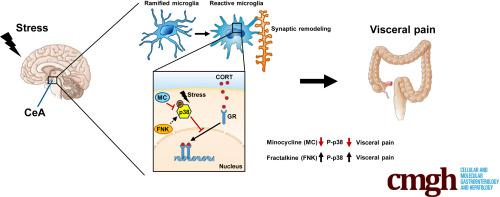Cellular and Molecular Gastroenterology and Hepatology ( IF 7.2 ) Pub Date : 2020-05-08 , DOI: 10.1016/j.jcmgh.2020.04.020 Tian Yuan 1 , Krishna Manohar 1 , Rocco Latorre 2 , Albert Orock 1 , Beverley Greenwood-Van Meerveld 3

|
Background & Aims
Psychological stress is a trigger for the development of irritable bowel syndrome and associated symptoms including abdominal pain. Although irritable bowel syndrome patients show increased activation in the limbic brain, including the amygdala, the underlying molecular and cellular mechanisms regulating visceral nociception in the central nervous system are incompletely understood. In a rodent model of chronic stress, we explored the role of microglia in the central nucleus of the amygdala (CeA) in controlling visceral sensitivity. Microglia are activated by environmental challenges such as stress, and are able to modify neuronal activity via synaptic remodeling and inflammatory cytokine release. Inflammatory gene expression and microglial activity are regulated negatively by nuclear glucocorticoid receptors (GR), which are suppressed by the stress-activated pain mediator p38 mitogen-activated protein kinases (MAPK).
Methods
Fisher-344 male rats were exposed to water avoidance stress (WAS) for 1 hour per day for 7 days. Microglia morphology and the expression of phospho-p38 MAPK and GR were analyzed via immunofluorescence. Microglia-mediated synaptic remodeling was investigated by quantifying the number of postsynaptic density protein 95–positive puncta. Cytokine expression levels in the CeA were assessed via quantitative polymerase chain reaction and a Luminex assay (Bio-Rad, Hercules, CA). Stereotaxic infusion into the CeA of minocycline to inhibit, or fractalkine to activate, microglia was followed by colonic sensitivity measurement via a visceromotor behavioral response to isobaric graded pressures of tonic colorectal distension.
Results
WAS induced microglial deramification in the CeA. Moreover, WAS induced a 3-fold increase in the expression of phospho-p38 and decreased the ratio of nuclear GR in the microglia. The number of microglia-engulfed postsynaptic density protein 95–positive puncta in the CeA was increased 3-fold by WAS, while cytokine levels were unchanged. WAS-induced changes in microglial morphology, microglia-mediated synaptic engulfment in the CeA, and visceral hypersensitivity were reversed by minocycline whereas in stress-naïve rats, fractalkine induced microglial deramification and visceral hypersensitivity.
Conclusions
Our data show that chronic stress induces visceral hypersensitivity in male rats and is associated with microglial p38 MAPK activation, GR dysfunction, and neuronal remodeling in the CeA.
中文翻译:

抑制杏仁核中的小胶质细胞激活可逆转雄性大鼠压力诱发的腹痛。
背景与目标
心理压力是引发肠易激综合征和相关症状(包括腹痛)的诱因。尽管肠易激综合征患者的边缘大脑(包括杏仁核)激活增加,但对调节中枢神经系统内脏伤害感受的潜在分子和细胞机制尚不完全了解。在慢性应激的啮齿动物模型中,我们探索了杏仁核 (CeA) 中央核中的小胶质细胞在控制内脏敏感性方面的作用。小胶质细胞被压力等环境挑战激活,并且能够通过突触重塑和炎性细胞因子释放来改变神经元活动。炎症基因表达和小胶质细胞活性受到核糖皮质激素受体 (GR) 的负调控,
方法
Fisher-344 雄性大鼠每天暴露于避水应激 (WAS) 下 1 小时,持续 7 天。通过免疫荧光分析小胶质细胞形态和磷酸-p38 MAPK 和 GR 的表达。通过量化突触后密度蛋白 95 阳性斑点的数量来研究小胶质细胞介导的突触重塑。通过定量聚合酶链反应和 Luminex 测定(Bio-Rad,Hercules,CA)评估 CeA 中的细胞因子表达水平。立体定向注入米诺环素的 CeA 以抑制或 fractalkine 激活小胶质细胞,然后通过对强直性结肠直肠扩张的等压分级压力的内脏运动行为反应测量结肠敏感性。
结果
WAS 在 CeA 中诱导小胶质细胞脱支。此外,WAS 诱导磷酸化 p38 表达增加 3 倍,并降低小胶质细胞中核 GR 的比例。通过 WAS,CeA 中被小胶质细胞吞噬的突触后密度蛋白 95 阳性斑点的数量增加了 3 倍,而细胞因子水平没有变化。WAS 诱导的小胶质细胞形态变化、小胶质细胞介导的 CeA 突触吞噬和内脏超敏反应被米诺环素逆转,而在应激幼鼠中,fractalkine 诱导小胶质细胞脱支和内脏超敏反应。
结论
我们的数据显示,慢性压力会诱导雄性大鼠的内脏超敏反应,并与小胶质细胞 p38 MAPK 激活、GR 功能障碍和 CeA 中的神经元重塑有关。


























 京公网安备 11010802027423号
京公网安备 11010802027423号